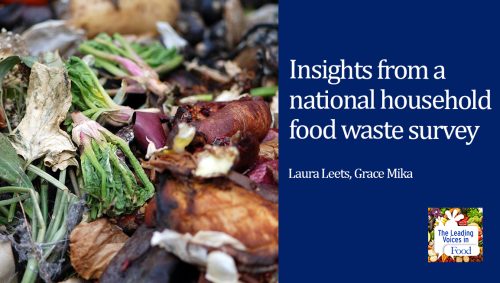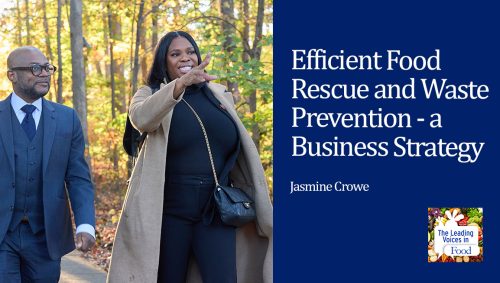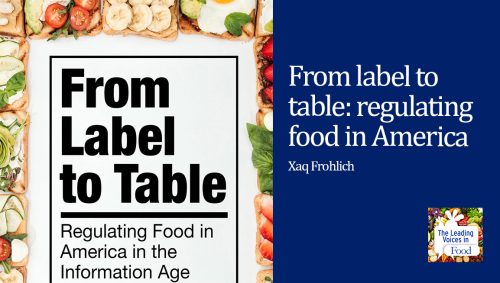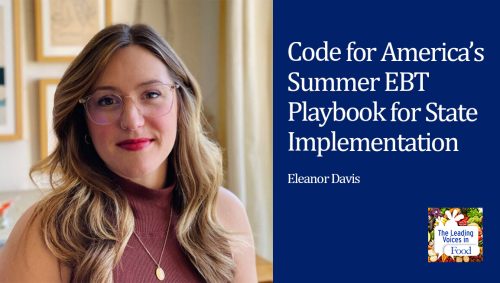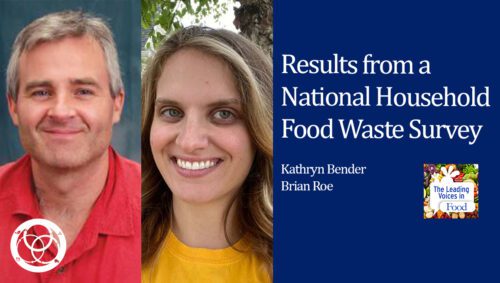The Leading Voices in Food
E195: How USDA is tackling food waste and loss
In the United States, over one third of all available food goes uneaten through loss or waste. That is a hard number to ignore when more than 10% of the US population is food insecure. What’s more, uneaten food is the single largest category of material sent to landfills. So what is the USDA doing to address food loss and waste? Our guest today is Dr. Jean Buzby, the Food Loss and Waste Liaison in the US Department of Agriculture’s Office of the Chief Economist.
Subscribe: Apple Podcasts | TuneIN | Google Podcasts | SoundCloud | PocketCasts | Radio Public
Tags: Climate Change, Environment & Food | Food Policy | Food Waste & Implications |

Jean C. Buzby, Ph.D., is the USDA Food Loss and Waste Liaison in the Office of the Chief Economist. Prior to this position, she worked for USDA’s Economic Research Service for more than 20 years, most recently as the Chief of the Diet, Safety, and Health Economics Branch in ERS’s Food Economics Division. Before moving into management, her primary areas of work as an agricultural economist at ERS were food safety and food consumption research. Jean’s food safety research included estimating the cost of foodborne illness, analyzing the legal incentives for firms to produce safer food, and exploring international trade and food safety issues. Her food consumption research was centered on information from the Food Availability Data System. She is domestically and internationally known for her research on the amount and value of food loss at the retail and consumer levels in the United States.
Interview Summary
Norbert: Welcome, Jean. It is great to have you. So what do you do in your position as the USDA Food Loss and Waste Liaison?
As the USDA Food Loss and Waste Liaison, I’m using my platform to raise awareness of food loss and waste, its associated challenges that you mentioned, Norbert, as well as the opportunities for businesses and consumers to save or make money by reducing it. I’ve worked with multiple partners in the corporate, nonprofit, academic, and government arenas to prevent or reduce food loss and waste. I work with colleagues from the different USDA agencies to increase food loss and waste activities within those agencies as well as with other federal partners in particular. We host, throughout the year, webinars highlighting food loss and waste reduction success stories. In recent years, we have hosted interesting USDA Food Loss and Waste Innovation Fair.
Norbert – That’s wonderful. As I remember, you were one of the earlier folks out there really using USDA data to begin thinking about what food loss and waste looks like. We really thank you for the work that you’ve done to begin this work.
Brenna – Jean, that actually leads us into one of my questions. The USDA is a big agency with really broad responsibilities. Can you tell us a little bit more about the scope of USDA’s work on food loss and waste?
Absolutely. The scope is quite broad. We do quite a lot of research, both in-house and extramural funding, for new food innovations and technologies that reduce food loss and waste. For example, our agricultural research service has over 2000 scientists and 90 research centers across the country. Some of those scientists work to develop new and heartier cultivars, such as the keepsake strawberry, which is flavorful and has a longer shelf life. They also have developed automated infield apple sorting systems that separate low quality from high quality apples at harvest with less bruising damage. And other innovations, such as in packaging. The USDA has the National Institute of Food and Agriculture, or NIFA, which does a lot of the extramural competitive funding that develops new technologies and innovations to reduce food loss and waste. For example, one novel technology is Jelly Ice, which doesn’t melt like traditional ice and it can be reused several times. And then ultimately composted when finished. So, it’s pretty exciting technology and just one of many. USDA produces education and tools. For example, we have a free FoodKeeper App which provides guidance on safe handling, preparation, and storage of more than 650 food and beverage items. And with this App, you can track storage times for different foods, learn cooking tips, and watch helpful videos, and get information on food recalls. We do a lot of funding through our different agencies. For example, Rural Development has funding, and grants, and loan programs that can provide cold storage infrastructure.
Brenna – Thank you for that broad overview, Jean. I know Norbert and I spend a lot of time thinking about food loss and waste, but you kind of forget all the different things that USDA does to work on that issue. Can you tell us about any other federal agencies that you work with to meet the national goal to reduce food loss and waste in half by 2030?
USDA has an ongoing inter-agency partnership with the US Environmental Protection Agency and the US Food and Drug Administration to improve coordination and communication efforts to educate Americans on the impacts and importance of reducing food loss and waste, and to help get some of these programs going. But these three agencies both have their individual activities as well as collective activities across the agencies that raise awareness and share resources for consumers, businesses, and others. One example of our inter-agency work is the USDA and the EPA have an initiative called the US Food Loss and Waste 2030 Champions program. This encourages the food corporations and businesses to make a public commitment to reducing food loss and waste in their own US operations by 50% by the year 2030, which, by the way, is a national and international goal to make that very ambitious reduction. Right now, we have about 50 2030 Champions, and these include companies across the food system, such as food service organization Aramark, hotel industry leader like Hilton, and grocery giant Kroger. You can learn more about the 2030 Champions by searching for USDA 2030 Champions. If you click on each icon, or the logo of each company, you can see what they’re doing in their own in-house activities. It’s very exciting and we are actively growing this program
Brenna – I think the number of champions has grown quite a lot so that’s great to hear.
Norbert – I really am happy to hear about the various companies that have engaged in helping reduce food waste. Brenna and I have worked on different projects looking at different actors along the food supply chain and their relationship to food waste. And one of the things that we do know is that consumers really are an important part of that challenge for us to reduce food waste by 50%. I would love to hear some of your thoughts of what can consumers do to help reduce food waste?
Absolutely, Norbert. You’re right; everybody has a role to play in reducing food loss and waste. A great first step is to be mindful of the food that we discard. We may not be aware of the amount of food we waste over the course of the year because it’s a little bit today, a little bit tomorrow, and over time. But an average family of four wastes about $1,500 of food that they purchase and then goes uneaten. That’s a big hit to the wallet and small choices add up. But consumers can take mini steps to reduce food waste in their own homes. Such as they can plan ahead; before we go to the grocery store or order online. We can make a list so we don’t buy more than we need. You can also love your leftovers. You can pack leftovers in small portions in shallow containers, and mark the contents and date, and then refrigerate it or freeze it immediately. You can even have a leftover night, like every Tuesday is for leftovers. You can also compost and not trash uneaten food. Food in landfills produces a harmful methane gas that’s 25 times more potent than carbon dioxide as a climate change gas. It’s really important to keep that food out of landfills. You can recycle your food scraps in a home compost bin or a local compost center. But there are many more steps and if you just search online, “USDA food loss and waste,” you’ll find we have a whole page just for consumers with lots of videos both in English and Spanish, as well as consumer outreach materials. I love the recommendation of “Love Your Leftovers.” I’m going to love some later on today so thank you so much for this.
Brenna – So the US has a national goal to cut food loss and waste in half by 2030. So I guess, bottom line, are you optimistic that we’ll reach that goal?
Well, it is a super ambitious goal and I really wish I had a crystal ball to know where we will be by 2030. I am encouraged by the momentum that I see by the public sector and the private sector. Both globally and domestically, there seems to be really increased awareness about food loss and waste. I certainly hope it takes off just as recycling did. But it’s important to recognize that the food loss and waste challenge itself is going to continue well after 2030. This issue is here to stay with a growing world population, limited resources, like finite amount of arable land and fresh water. And also our growing awareness of the connections between food loss and waste, and the environment. We’ll have to continue to address this issue beyond 2030 as well. Some of the key takeaways I’d love to share with you is that food loss and waste is really complex and it’s going to take many different solutions from farm to table. There is no silver bullet. These solutions are going to be many, and will include, likely, public-private partnerships, as well as increased consumer education. As I mentioned before really everyone has a role to play in reducing food loss and waste.
Norbert – All great points, Jean. Thank you so much for your perspectives on this issue. One of the things that I took away from this conversation is this is a systemic challenge and it’s going to take a systemic approach to help us reduce food loss and waste throughout the supply chain. Thank you for giving us that perspective and also for your optimism. I’m excited about the potential and the work that several of us are doing are all moving towards that goal.

